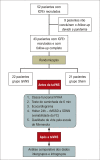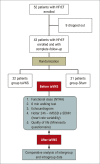Auricular Vagal Neuromodulation and its Application in Patients with Heart Failure and Reduced Ejection Fraction
- PMID: 37194830
- PMCID: PMC10263391
- DOI: 10.36660/abc.20220581
Auricular Vagal Neuromodulation and its Application in Patients with Heart Failure and Reduced Ejection Fraction
Abstract
Background: The autonomic nervous system (ANS) imbalance in heart failure (HF) creates a vicious cycle, excess sympathetic activity, and decreased vagal activity contributing to the worsening of HF. Low-intensity transcutaneous electrical stimulation of the auricular branch of the vagus nerve (taVNS) is well tolerated and opens new therapeutic possibilities.
Objectives: To hypothesize the applicability and benefit of taVNS in HF through intergroup comparison of echocardiography parameters, 6-minute walk test, Holter heart rate variability (SDNN and rMSSD), Minnesota quality of life questionnaire, and functional class by the New York Heart Association. In comparisons, p values <0.05 were considered significant.
Methods: Prospective, double-blind, randomized clinical study with sham methodology, unicentric. Forty-three patients were evaluated and divided into 2 groups: Group 1 received taVNS (frequencies 2/15 Hz), and Group 2 received sham. In comparisons, p values <0.05 were considered significant.
Results: In the post-intervention phase, it was observed that Group 1 had better rMSSD (31 x 21; p = 0.046) and achieved better SDNN (110 vs. 84, p = 0.033). When comparing intragroup parameters before and after the intervention, it was observed that all of them improved significantly in group 1, and there were no differences in group 2.
Conclusion: taVNS is a safe to perform and easy intervention and suggests a probable benefit in HF by improving heart rate variability, which indicates better autonomic balance. New studies with more patients are needed to answer the questions raised by this study.
Fundamento: O desequilíbrio do sistema nervoso autônomo (SNA) na insuficiência cardíaca (IC) cria um ciclo vicioso, o excesso de atividade simpática e a diminuição da atividade vagal contribuindo para a piora da IC. A estimulação elétrica transcutânea de baixa intensidade do ramo auricular do nervo vago (taVNS) é bem tolerada e abre novas possibilidades terapêuticas.
Objetivos: Gerar hipótese da aplicabilidade e benefício da taVNS na IC através da comparação intergrupos de parâmetros ecocardiográficos, teste de caminhada de 6 min, variabilidade da frequência cardíaca pelo Holter (SDNN e rMSSD), questionário de qualidade de vida de Minnesota e classe funcional pela New York Heart Association.
Métodos: Estudo clínico prospectivo, duplo cego, randomizado com metodologia sham, unicêntrico. Avaliados 43 pacientes e alocados em 2 grupos: o Grupo 1 recebeu taVNS (frequências 2/15 Hz) e Grupo 2 recebeu sham. Nas comparações, valores de p<0,05 foram considerados significativos.
Resultados: Na fase pós-intervenção, observou-se que o Grupo 1 se manteve com melhor rMSSD (31 x 21; p = 0,046) e atingiu melhor SDNN (110 vs. 84, p = 0,033). Ao compararmos os parâmetros intragrupos, antes e após intervenção, observou-se que todos melhoraram significativamente no grupo 1 e não houve diferenças no grupo 2.
Conclusão: A taVNS é uma intervenção segura, de fácil execução e que sugere provável benefício na IC pela melhora na variabilidade da frequência cardíaca, o que indica melhor equilíbrio autonômico. Novos estudos com maior número de pacientes são necessários para responder às questões levantadas por esse estudo.
Conflict of interest statement
Potencial conflito de interesse
Não há conflito com o presente artigo
Figures











Comment in
-
Auricular Vagus Nerve Stimulation in Heart Failure: Critical Analysis and Future Perspectives.Arq Bras Cardiol. 2023 Jun 19;120(5):e20230298. doi: 10.36660/abc.20230298. Arq Bras Cardiol. 2023. PMID: 37341251 Free PMC article. English, Portuguese. No abstract available.
References
-
- Zipes D, Libby P, Bonow RO, Mann DL, Tomaselli GF.editors . Braunwald’s Heart Disease: A Textbook of Cardiovascular Medicine . 12th. Amsterdã: Elsevier; 2022.
-
- McDonagh TA, Metra M, Adamo M, Gardner RS, Baumbach A, Böhm M, et al. 2021 ESC Guidelines for the Diagnosis and Treatment of Acute and Chronic Heart Failure: Developed by the Task Force for the Diagnosis and Treatment of Acute and Chronic Heart Failure of the European Society of Cardiology (ESC). With the Special Contribution of the Heart Failure Association (HFA) of the ESC. Eur J Heart Fail . 2022;24(1):4–131. doi: 10.1002/ejhf.2333. - DOI - PubMed
Publication types
MeSH terms
LinkOut - more resources
Full Text Sources
Medical
Research Materials
Miscellaneous

